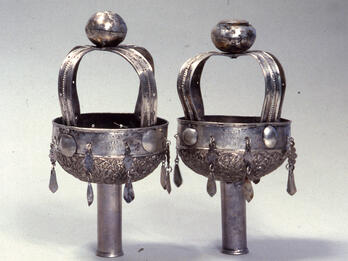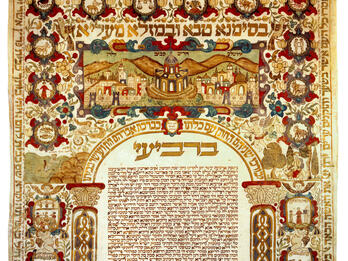Gelilot erets Yisra’el (Regions of the Land of Israel)
First, we will describe how to travel from one’s land to Israel. There are many ways by which one can travel. One route is from Venice and another is from the city of Ofen [Budapest], but there is no better route than to travel from Kamieniec Podolski to the city of Iaşi which lies in the country of Walachia, which is called Bogdania [later Moldavia]. And from Iaşi one travels to Galaţi, which lies on the Danube; this is a mighty river, and there one boards a ship and sails on the Danube for two hours. Then one arrives in a Turkish village, this is the border of Turkey, and from there one travels to the holy community of Provadia, which used to be on the seashore. The sea retreated from there a distance of one day’s journey and in the place where the sea flowed, a city was built and this is this city of Provadia. And there are still [archaeological] remnants in the earth, such as bits of ancient boards from ships. And from there one travels to the holy community of Karnobat and from there to the holy community of Adrianople [Edirne]. In Adrianople one discovers if there is a ship there, from where it is coming or when it will depart, because people generally travel from the holy community of Gallipoli or the holy community of Little Rhodes [Tekirdağ]; the two cities stand in the salt sea and are not more than three days from Adrianople. However, if the ship sails from Constantinople one travels directly from Adrianople to the holy community of Constantinople. And there Job is buried.
And there are many routes overland from Constantinople to Damascus and one need not sail on the sea more than one techum shabbat [kilometer] until the city of Scutari [Üsküdar]. And there Alexander of Macedonia connected the White Sea to the Black Sea. And from Scutari overland to Ankara [ . . . ] and after eight days’ journey to the city of Tyre. And from there to Amasya it is six days’ journey and from there to Tokat it is three days’ journey, from Tokat to the city of Aleppo it is four days’ journey. The same is true for Aram-Naharaim.1 And from Aleppo to the city of Tevrad [Jobar] it is thirteen days’ journey and from there to Damascus it is one day’s journey. And in Damascus is the Eliyahu ha-Navi Synagogue and his study house. And the Amana [Barada] and Pharpar rivers flow before the city and water all the gardens. And when one comes to the city of Tevrad, one finds the Ezra ha-Sofer synagogue located in a field wherein is a beautiful holy ark as well as his ink and his pen which are also there, there he wrote the prayers with them. But one must not open the holy ark because whoever sees the Torah scroll must die. And underneath is another ark out of which one takes [the Torah scroll] and prays minḥah gedolah [the daily afternoon service]. And the Turks call this city Tevrad because it is the Turkish word for Torah, referring to Ezra’s Torah. It is a long journey there and the expenses are very great.
Yet when one cannot find a ship, then one travels from the holy community of Gallipoli to the holy community of Rhodes; it costs one thaler with the ship to travel and from Rhodes to Sidon. [ . . . ] And then one is in the land of Israel. And one travels on overland to Jerusalem, may it be rebuilt speedily in our days. [ . . . ]
From there I traveled to the grave of the prophet Ezekiel. But it is a long way to there. One must travel through the desert. And there, not far off, is the grave of Baruch ben Neriah the prophet.
It once happened that the king said to a Jew named R. Solomon, “Come with me, I wish to dig up the prophet Ezekiel and see him because I have heard that he performed many miracles in one day.” So answered the Jew, “God forbid you should dig him up and see him. But I will give you a piece of advice. Not far from there lies Baruch ben Neriah who was his student and was also a prophet. If you can see him, then you can see his teacher.” So, the king said to him, “You speak correctly.” Thus, the king sent for all his ministers and sages to see the prophet Baruch ben Neriah and they all gathered, and the king too, to open the grave. And all those who began to dig died immediately and straightaway. So, said one old Ishmaelite, “My lord, he was a Jew and the Jews learn Torah. Ask them to dig him up.” So the king ordered the Jews to dig him up. The Jews begged the king to give them three days’ grace, so that they could repent and so God would forgive them. Therefore, he granted the Jews three days. In the meantime, the Jews repented, prayed, gave charity, and fasted. And after three days, the king sent for the Jews to open the grave. The king and all his ministers went to see the prophet. The Jews opened the grave and no one was harmed. They found him in a marble coffin lying as when he had just died. The king said, “It is not worthy for both to lie next to each other, but rather we will take the coffin and put it in another city.” So the Jews took the coffin and moved it a distance of one techum. The coffin would go no further. The king brought many camels, donkeys, and horses so that they could drag the coffin from its place. But they could not move it from its place. So said R. Solomon to the king, “It is possible that he chose this place while he was still alive.” Immediately, the king ordered that he be buried there. Directly the Jews buried the coffin in that same place and built a beautiful study house there. And when the king saw that Baruch ben Neriah the prophet had not decayed, neither he nor his shrouds, they went straight away to Mecca, the king and his slaves, to see Mohammed their false prophet who is buried there, whether he had decayed or not. And directly, when he and his servants saw that he [Mohammed] stinks so that one cannot approach him, he and his slaves converted to Judaism and said, “The Torah of Moses is the truth.” And there is a kind of bush on the leaves of which grow sparks of gold. And at night the people make signs where the bushes grow and on which there is gold, and by day they tear them up.
And the grave of Baruch ben Neriah is one techum from the grave of Ezekiel. And at the grave of Ezekiel, everyone gives money for charity to light a candle at his grave. And whoever places money on his grave, no one else can take it, apart from the person who placed it there. And when someone who had placed money on the grave dies and his heirs know about this and they come and want to take this money, they find the money lying there just as before.
Notes
[Aram-Naharaim is the biblical term for the northern Syrian section of the Euphrates.—Trans.]
Credits
Published in: The Posen Library of Jewish Culture and Civilization, vol. 5.




